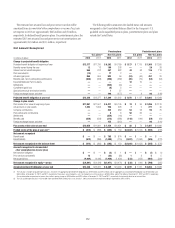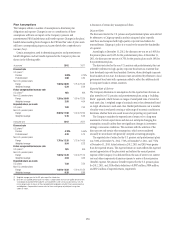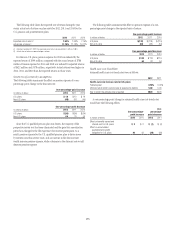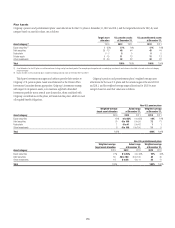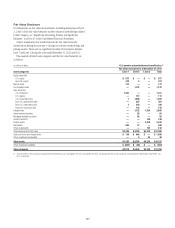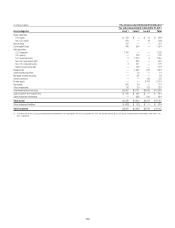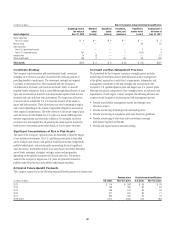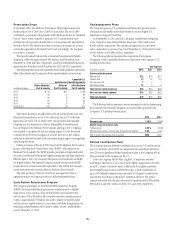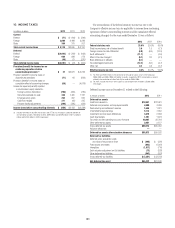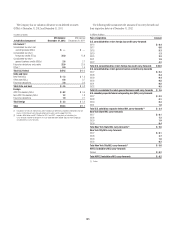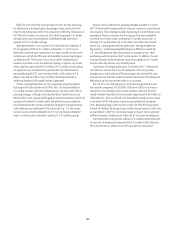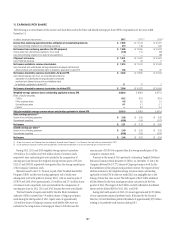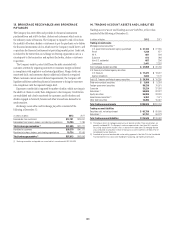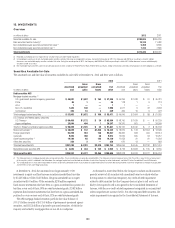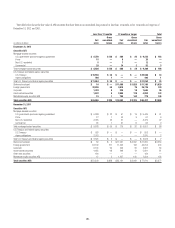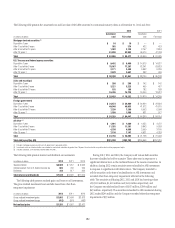Citibank 2012 Annual Report Download - page 204
Download and view the complete annual report
Please find page 204 of the 2012 Citibank annual report below. You can navigate through the pages in the report by either clicking on the pages listed below, or by using the keyword search tool below to find specific information within the annual report.
182
Prescription Drugs
In December 2003, the Medicare Prescription Drug Improvement and
Modernization Act of 2003 (Act of 2003) was enacted. The Act of 2003
established a prescription drug benefit under Medicare known as “Medicare
Part D,” and a federal subsidy to sponsors of U.S. retiree health-care
benefit plans that provide a benefit that is at least actuarially equivalent to
Medicare Part D. The benefits provided to certain participants are at least
actuarially equivalent to Medicare Part D and, accordingly, the Company
is entitled to a subsidy.
The expected subsidy reduced the accumulated postretirement benefit
obligation (APBO) by approximately $93 million and $96 million as of
December 31, 2012 and 2011, respectively, and the postretirement expense by
approximately $9 million and $10 million for 2012 and 2011, respectively.
The following table shows the estimated future benefit payments without the
effect of the subsidy and the amounts of the expected subsidy in future years:
Expected U.S.
postretirement benefit payments
In millions of dollars
Before Medicare
Part D subsidy
Medicare
Part D subsidy
After Medicare
Part D subsidy
2013 $ 98 $10 $ 88
2014 96 10 86
2015 94 8 86
2016 91 8 83
2017 89 8 81
2018–2022 399 29 370
The Patient Protection and Affordable Care Act and the Health Care and
Education Reconciliation Act of 2010 (collectively, the Act of 2010) were
signed into law in the U.S. in March 2010. One provision that impacted
Citigroup was the elimination of the tax deductibility for benefits paid
that are related to the Medicare Part D subsidy, starting in 2013. Citigroup
was required to recognize the full accounting impact in 2010, the period
in which the Act of 2010 was signed. As a result, there was a $45 million
reduction in deferred tax assets with a corresponding charge to earnings from
continuing operations.
Certain provisions of the Act of 2010 improved the Medicare Part D option
known as the Employer Group Waiver Plan (EGWP), with respect to the
Medicare Part D subsidy. The EGWP provides prescription drug benefits that
are more cost effective for Medicare-eligible participants and large employers.
Effective April 1, 2013, the Company will sponsor and implement an EGWP
for eligible retirees. The expected Company subsidy received under EGWP
is expected to be at least actuarially equivalent to the subsidy the Company
would have previously received under the Medicare Part D benefit.
The other provisions of the Act of 2010 are not expected to have a
significant impact on Citigroup’s pension and postretirement plans.
Early Retiree Reinsurance Program
The Company participates in the Early Retiree Reinsurance Program
(ERRP), which provides federal government reimbursement to eligible
employers to cover a portion of the health benefit costs associated with
early retirees. Of the $8 million the Company received in reimbursements
in 2012, approximately $5 million was used to reduce the health benefit
costs for certain eligible retirees. In accordance with federal regulations, the
remaining reimbursements will be used to reduce retirees’ health benefit
costs by December 31, 2014.
Postemployment Plans
The Company sponsors U.S. postemployment plans that provide income
continuation and health and welfare benefits to certain eligible U.S.
employees on long-term disability.
As of December 31, 2012 and 2011, the plans’ funded status recognized
in the Company’s Consolidated Balance Sheet was $(501) million and
$(469) million, respectively. The amounts recognized in Accumulated
other comprehensive income (loss) as of December 31, 2012 and 2011 were
$(185) million and $(188) million, respectively.
The following table summarizes the components of net expense
recognized in the Consolidated Statement of Income for the Company’s U.S.
postemployment plans.
Net Expense
In millions of dollars 2012 2011 2010
Service related expense
Service cost $22 $16 $13
Interest cost 13 12 10
Prior service cost 77 7
Net actuarial loss 13 9 6
Total service related expense $55 $44 $36
Non-service related expense $24 $23 $33
Total net expense $79 $67 $69
The following table summarizes certain assumptions used in determining
the postemployment benefit obligations and net benefit expenses for the
Company’s U.S. postemployment plans.
2012 2011
Discount rate 3.10% 3.95%
Health-care cost increase rate
Following year 8.50% 9.00%
Ultimate rate to which cost increase is assumed to decline 5.00 5.00
Year in which the ultimate rate is reached 2020 2020
Defined Contribution Plans
The Company sponsors defined contribution plans in the U.S. and in certain
non-U.S. locations, all of which are administered in accordance with local
laws. The most significant defined contribution plan is the Citigroup 401(k)
Plan sponsored by the Company in the U.S.
Under the Citigroup 401(k) Plan, eligible U.S. employees received
matching contributions of up to 6% of their eligible compensation for 2012
and 2011, subject to statutory limits. Additionally, for eligible employees
whose eligible compensation is $100,000 or less, a fixed contribution of
up to 2% of eligible compensation is provided. All Company contributions
are invested according to participants’ individual elections. The pretax
expense associated with this plan amounted to approximately $389 million,
$383 million and $301 million in 2012, 2011 and 2010, respectively.


